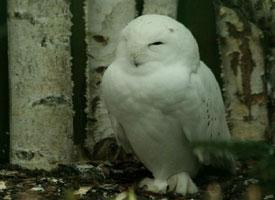
Weights and measures
| Length | from 81 to 105 cm |
|---|---|
| Weight | from 385 to 800 g |
State of endangerment
| Endangered |
Animal description
The Tawny Owl (Strix aluco) is a fascinating bird species that is widely recognized for its distinctive call and captivating appearance. This medium-sized owl is native to much of Europe and parts of Asia, thriving in a range of habitats including dense woodlands, gardens, and parks. Its adaptability to different environments has made it one of the most common and widespread owl species within its range.Physical Description:
The Tawny Owl is notable for its rounded body, large head, and absence of ear tufts, characteristics that distinguish it from other owl species. It typically measures about 37 to 39 centimeters in length, with a wingspan ranging from 81 to 105 centimeters. The bird exhibits sexual dimorphism, with females generally larger than males. The plumage of the Tawny Owl is a rich mix of brown and grey, featuring intricate patterns that provide excellent camouflage against tree bark. This camouflage is vital for daytime roosting and avoiding predators. Its underparts are paler with dark streaks, and it has a distinctive facial disc that is framed by a dark rim. The large, round eyes of the Tawny Owl are dark brown, almost black, which is unusual among owls as most species have yellow or orange eyes.
Habitat and Distribution:
Tawny Owls are highly adaptable and can inhabit a wide range of environments. They prefer deciduous or mixed woodlands but are also found in coniferous forests, parks, and gardens. Their ability to thrive in close proximity to human habitation has made them a familiar presence in rural and even urban settings across Europe and parts of Asia. Despite their adaptability, Tawny Owls require territories with suitable nesting sites and ample food supply, which typically includes small mammals, birds, insects, and other small creatures.
Behavior and Diet:
The Tawny Owl is a nocturnal predator, hunting primarily at night using its exceptional hearing and keen eyesight to locate prey. It has a varied diet that mainly consists of small mammals such as mice, voles, and shrews, but it will also prey on small birds, insects, and amphibians. The Tawny Owl is known for its silent flight, a characteristic facilitated by the specialized fringes on the edges of its feathers, allowing it to swoop down on its prey unnoticed.
Reproduction:
Tawny Owls are monogamous birds, often forming lifelong pairs. They nest in tree cavities, old crow nests, or even in specially designed nest boxes. The breeding season typically begins in March or April, with the female laying a clutch of 2 to 4 eggs. The eggs are incubated primarily by the female for about 30 days, during which the male provides food. Once hatched, the owlets are cared for by both parents and are ready to fledge approximately 35 to 40 days later, though they may remain dependent on their parents for several more weeks.
Vocalizations:
One of the most distinctive features of the Tawny Owl is its vocalization. The male's call is a deep, resonant "hoot" that can be heard over long distances, primarily used to proclaim territory and attract a mate. The female's response is a sharper, kewick sound. These calls are among the most recognizable sounds of the night in areas where Tawny Owls reside.
Conservation Status:
Currently, the Tawny Owl is classified as Least Concern by the International Union for Conservation of Nature (IUCN), thanks to its wide distribution and large population. However, like many wildlife species, it faces threats from habitat destruction, pollution, and collisions with vehicles and structures. Conservation efforts are focused on preserving natural habitats and promoting awareness to mitigate these threats.
In conclusion, the Tawny Owl is a remarkable bird, embodying the mystery and allure of the nocturnal wildlife. Its adaptability and presence in diverse habitats make it a key species in understanding the health of ecosystems across its range.
Map of occurrence

Similar Animals
New photos of animals
Top 10 animals
- Dolphin gull (Leucophaeus scoresbii)
- Diana monkey (Cercopithecus diana)
- Moustached guenon (Cercopithecus cephus)
- Galápagos tortoise (Geochelone nigra complex)
- Japanese macaque (Macaca fuscata)
- Russian tortoise (Testudo horsfieldii)
- Stone loach (Barbatula barbatula)
- Greek tortoise (Testudo graeca)
- Common flying dragon (Draco volans)
- Vendace (Coregonus albula)


